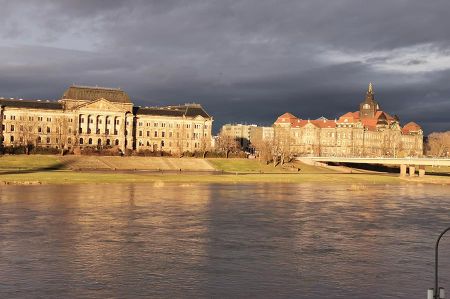Frauenkirche Dresden – in the catacombs of the lower church
- Written by Portal Editor
We were traveling in Dresden again and as the opening picture clearly indicates: it wasn't a really nice day that invited us to linger on the Elbe promenade.
Flooding in the river and constant rain, every now and then it became apparent that the sun was still there. Well, there was still some time until our appointment and since we don't mind getting wet, we set off on another tour, especially since the approaching lunchtime was already in the stomach area and we had a little something to eat wanted to.
The first route took us to the Frauenkirche
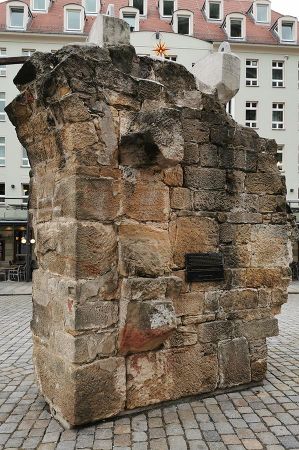 However, our path then led us straight to the Frauenkirche, probably the most symbolic building in the city, whose tragic story is almost over and is now known to everyone. During the firestorm triggered by the air raids on Dresden at the end of the Second World War on the night of February 13th and 14th, 1945, the church's supporting structure was so weakened that it burned out and collapsed on the morning of February 15th.
However, our path then led us straight to the Frauenkirche, probably the most symbolic building in the city, whose tragic story is almost over and is now known to everyone. During the firestorm triggered by the air raids on Dresden at the end of the Second World War on the night of February 13th and 14th, 1945, the church's supporting structure was so weakened that it burned out and collapsed on the morning of February 15th.
On the night of February 13th to 14th, 1945, 300 people found shelter in the church cellars. After it started burning, this group had difficulty getting out of the rooms as the fire spread rapidly. For years, the ruins in the GDR were seen as a memorial against war and destruction, but the desire to rebuild always remained. Nevertheless, a full 60 years passed before the Frauenkirche was able to open its doors to the people again in 2005 in its full baroque beauty.
Political meeting point for the peace movement
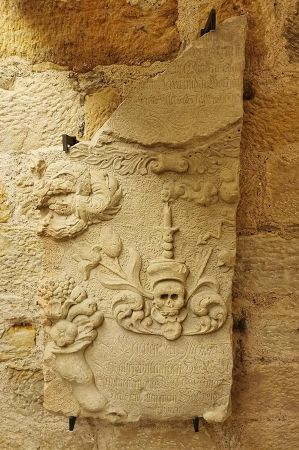 For many years and always on February 13th, an independent peace movement protested at the ruins with candles against the militarization of the GDR. After the so-called Peaceful Revolution in the GDR, the clearing of rubble began in early 1993 and the reconstruction of the church building began in 1994.
For many years and always on February 13th, an independent peace movement protested at the ruins with candles against the militarization of the GDR. After the so-called Peaceful Revolution in the GDR, the clearing of rubble began in early 1993 and the reconstruction of the church building began in 1994.
Before the reconstruction of the actual church building began, the lower church was rebuilt. This meant that space could be created for church services, guided tours and concerts before the finished church building opened. The consecration of the lower church took place on August 21, 1996.
The work, completed in 2005, was largely financed by support associations and donors from all over the world, including the US “Friends of Dresden”. On October 30, 2005, a consecration service and ceremony took place in the Frauenkirche. The memorial against war and violence has now become a symbol of reconciliation.
Tour through the church and down to the lower church
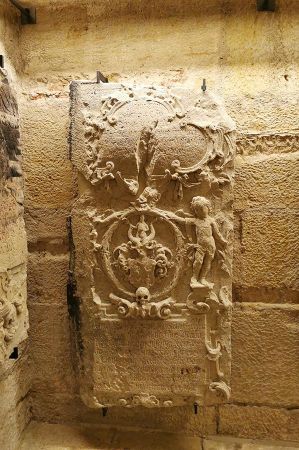 We first walked around the Frauenkirche and came across the fragment of the church dome shown in the picture, which also contains an important message from the church's chief inspector Weinert.
We first walked around the Frauenkirche and came across the fragment of the church dome shown in the picture, which also contains an important message from the church's chief inspector Weinert.
When we entered the church, we were initially quite surprised to see the many window fronts on the galleries, which shielded the rooms behind them as private places of worship for the richer citizens within the church. All people are equal? Shouldn’t this be especially true in churches? Well, where is there real justice?
After a few inquiries, we found the entrance to the lower church, which at least partially survived the firestorm of 1945.
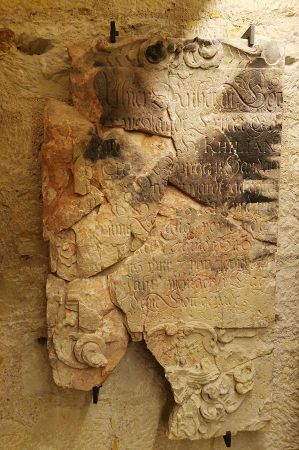 The lower church of the Dresden Frauenkirche has the shape of a Greek cross, in the diagonal arms of the cross shape there are four rooms.
The lower church of the Dresden Frauenkirche has the shape of a Greek cross, in the diagonal arms of the cross shape there are four rooms.
These rooms were used for burials from 1728 onwards and were a replacement for the cemetery that had once surrounded the previous Gothic church and was closed when the baroque Frauenkirche was rebuilt.
Between 1728 and 1787, 244 burials took place in the crypt chambers. When the Frauenkirche was destroyed, only the southwestern burial chamber remained undamaged. The placement of the coffins in the brick graves has also been largely preserved.
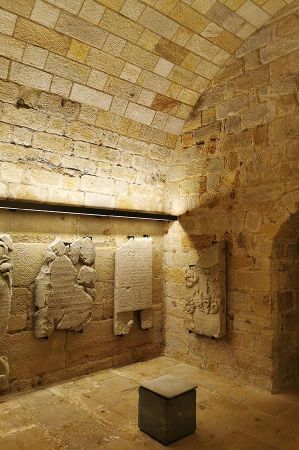 The other grave rooms were re-vaulted during the reconstruction and now serve as prayer chapels.
The other grave rooms were re-vaulted during the reconstruction and now serve as prayer chapels.
The choir chapel, located in the eastern part of the lower church, is located directly under the chancel of the main church. Two multi-part, architectural sculptures by Michael Schoenholtz symbolically contrast destruction and construction.
Both sculptures consist of elements that are identical in dimensions. While the destruction still allows certain speculations about the original form, the structure is not yet in a completed state.
Irish altar stone in the lower church
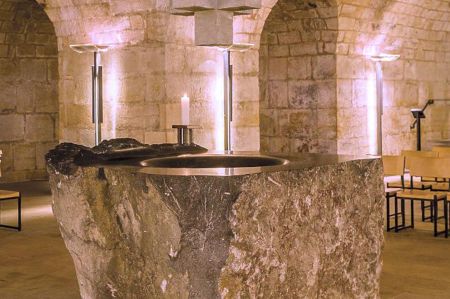 After entering the lower church as first-time visitors, our eyes quickly turned to the black-grey monolith in the middle of the room. The altar stone made of black Irish limestone placed at the apex of the cross-shaped barrel vault is a real eye-catcher in terms of its size and massiveness. In May 1996 the raw stone reached the construction site at the Frauenkirche. Shortly before the main vault of the lower church was closed, the 11-ton block was lowered using a crane. In July, Anish Kapoor began the artistic work to create the element as an altar stone. Born in Mumbai in 1954 as the son of an Indian Hindu and an Iraqi Jew, Anish Kapoor grew up between cultures and religions and drew inspiration and strength from them. He turned to art as a teenager and, after a few years in an Israeli kibbutz, went to England to study.
After entering the lower church as first-time visitors, our eyes quickly turned to the black-grey monolith in the middle of the room. The altar stone made of black Irish limestone placed at the apex of the cross-shaped barrel vault is a real eye-catcher in terms of its size and massiveness. In May 1996 the raw stone reached the construction site at the Frauenkirche. Shortly before the main vault of the lower church was closed, the 11-ton block was lowered using a crane. In July, Anish Kapoor began the artistic work to create the element as an altar stone. Born in Mumbai in 1954 as the son of an Indian Hindu and an Iraqi Jew, Anish Kapoor grew up between cultures and religions and drew inspiration and strength from them. He turned to art as a teenager and, after a few years in an Israeli kibbutz, went to England to study.
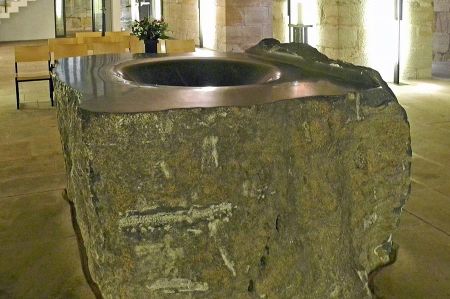 When Anish Kapoor accepted the commission for an altar stone for the lower church of the Frauenkirche, an artist with Jewish roots created an altar for a German church for the first time since 1945.
When Anish Kapoor accepted the commission for an altar stone for the lower church of the Frauenkirche, an artist with Jewish roots created an altar for a German church for the first time since 1945.
After its consecration, the Cross of Nails of Coventry, which was presented by the Bishop of Coventry as a sign of reconciliation, was also in the lower church. Since then, the Frauenkirche has been part of the international Cross of Nails community. Since the Frauenkirche was consecrated, the cross has stood on the altar of the main church.
After this really impressive visit, there was something good to satisfy the increasing hunger: a Spanish restaurant had already attracted us on the way to the Frauenkirche.
Please read as well:
With the young-timer Yamaha XJ 1100 to Hattingen
Sunday walk to the Abtsküche reservoir
-
 Dresden Church below Frauenkirche
Dresden Church below Frauenkirche
Dresden Church below Frauenkirche
Dresden Church below Frauenkirche
-
 Dresden Church below Frauenkirche
Dresden Church below Frauenkirche
Dresden Church below Frauenkirche
Dresden Church below Frauenkirche
-
 Dresden Church below Frauenkirche
Dresden Church below Frauenkirche
Dresden Church below Frauenkirche
Dresden Church below Frauenkirche
-
 Dresden Church below Frauenkirche
Dresden Church below Frauenkirche
Dresden Church below Frauenkirche
Dresden Church below Frauenkirche
-
 Dresden Church below Frauenkirche
Dresden Church below Frauenkirche
Dresden Church below Frauenkirche
Dresden Church below Frauenkirche
-
 Dresden Church below Frauenkirche
Dresden Church below Frauenkirche
Dresden Church below Frauenkirche
Dresden Church below Frauenkirche
https://www.alaturka.info/en/germany/saxony/6539-frauenkirche-dresden-in-the-catacombs-of-the-lower-church#sigProId8a28447126
